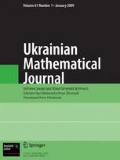We consider a model of market for which the jump of the stock price is uniformly distributed over a certain symmetric interval. By using the theorem on asymptotic expansions of the distribution function of the sum of independent identically distributed random variables, we determine the rate of convergence of fair prices for the European options. It is shown that, in the prelimit model, there exists a martingale measure on the market such that the rate of convergence of the prices of European options to the Black-Scholes price has an order of 1/n 1/2.
Similar content being viewed by others
References
W. J. Runggaldier and M. Schweizer, “Convergence of option values under incompleteness,” in: Proc. of the Seminar on the Stochastic Analysis, Random Fields, and Applications Held at the Centro Stefano Franscini (Ascona, Switzerland, June 7–12, 1993), Birkhäuser, Basel (1995), pp. 365–384.
F. Hubalek and W. Schachermayer, “When does convergence of asset price processes imply convergence of option prices,” Math. Finance, 4, 385–403 (1998).
J.-L. Prigent, “Incomplete markets: convergence of option values under the minimal martingale measure, ” Adv. Appl. Probab., 4, 1058–1077 (1999).
J.-P. Lesne, J.-L. Prigent, and O. Scaillet, “Convergence of discrete time option pricing models under stochastic interest rates,” Finance Stochast., 1, 81–93 (2000).
N. J. Cutland, E. Kopp, and W. Willinger, “From discrete to continuous financial models: new convergence results for option pricing,” Math. Finance, 2, 101–123 (1993).
D. Leisen, “The random time binomial model,” J. Econ. Dynam. Control, 9-10, 1355–1386 (1999).
M. Broadie, O. Glafferman, and S. J. Kou, “Connecting discrete continuous path-dependent options, ” Finance Stochast., 3, 55–82 (1999).
J. B. Walsh, “The rate of convergence of the binomial tree scheme,” Finance Stochast., 7, 337–361 (2003).
Lo-Bin Chang and K. Palmer, “Smooth convergence in the binomial model,” Finance Stochast., 11, 91–105 (2007).
H. Föllmer and A. Schied, Stochastic Finance: An Introduction in Discrete Time, de Gruyter, Berlin (2005).
V. V. Petrov, Sums of Independent Random Variables [in Russian], Nauka, Moscow (1972).
Author information
Authors and Affiliations
Additional information
Translated from Ukrains'kyi Matematychnyi Zhurnal, Vol. 60, No. 8, pp. 1075–1086, August, 2008.
Rights and permissions
About this article
Cite this article
Mishura, Y.S., Soloveiko, O.M. Rate of convergence of the price of European option on a market for which the jump of stock price is uniformly distributed over an interval. Ukr Math J 60, 1254–1269 (2008). https://doi.org/10.1007/s11253-009-0128-x
Received:
Revised:
Published:
Issue Date:
DOI: https://doi.org/10.1007/s11253-009-0128-x


